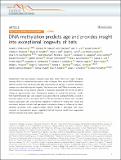DNA methylation predicts age and provides insight into exceptional longevity of bats
Abstract
Exceptionally long-lived species, including many bats, rarely show overt signs of aging, making it difficult to determine why species differ in lifespan. Here, we use DNA methylation (DNAm) profiles from 712 known-age bats, representing 26 species, to identify epigenetic changes associated with age and longevity. We demonstrate that DNAm accurately predicts chronological age. Across species, longevity is negatively associated with the rate of DNAm change at age-associated sites. Furthermore, analysis of several bat genomes reveals that hypermethylated age- and longevity-associated sites are disproportionately located in promoter regions of key transcription factors (TF) and enriched for histone and chromatin features associated with transcriptional regulation. Predicted TF binding site motifs and enrichment analyses indicate that age-related methylation change is influenced by developmental processes, while longevity-related DNAm change is associated with innate immunity or tumorigenesis genes, suggesting that bat longevity results from augmented immune response and cancer suppression.
Citation
Wilkinson , G S , Adams , D M , Haghani , A , Lu , A T , Zoller , J , Breeze , C E , Arnold , B D , Ball , H C , Carter , G G , Cooper , L N , Dechmann , D K N , Devanna , P , Fasel , N J , Galazyuk , A V , Günther , L , Hurme , E , Jones , G , Knörnschild , M , Lattenkamp , E Z , Li , C Z , Mayer , F , Reinhardt , J A , Medellin , R A , Nagy , M , Pope , B , Power , M L , Ransome , R D , Teeling , E C , Vernes , S C , Zamora-Mejías , D , Zhang , J , Faure , P A , Greville , L J & Horvath , S 2021 , ' DNA methylation predicts age and provides insight into exceptional longevity of bats ' , Nature Communications , vol. 12 , 1615 . https://doi.org/10.1038/s41467-021-21900-2
Publication
Nature Communications
Status
Peer reviewed
ISSN
2041-1723Type
Journal article
Description
This work was supported by a Paul G. Allen Frontiers Group grant to S.H., the University of Maryland, College of Computer, Mathematical and Natural Sciences to G.S.W., an Irish Research Council Consolidator Laureate Award to E.C.T., a UKRI Future Leaders Fellowship (MR/T021985/1) to S.C.V. and a Discovery Grant from the Natural Sciences and Engineering Research Council (NSERC) of Canada to P.A.F. S.C.V. and P.D. were supported by a Max Planck Research Group awarded to S.C.V. by the Max Planck Gesellschaft, and S.C.V. and E.Z.L. were supported by a Human Frontiers Science Program Grant (RGP0058/2016) awarded to S.C.V. L.J.G. was supported by an NSERC PGS-D scholarship.Collections
Items in the St Andrews Research Repository are protected by copyright, with all rights reserved, unless otherwise indicated.

